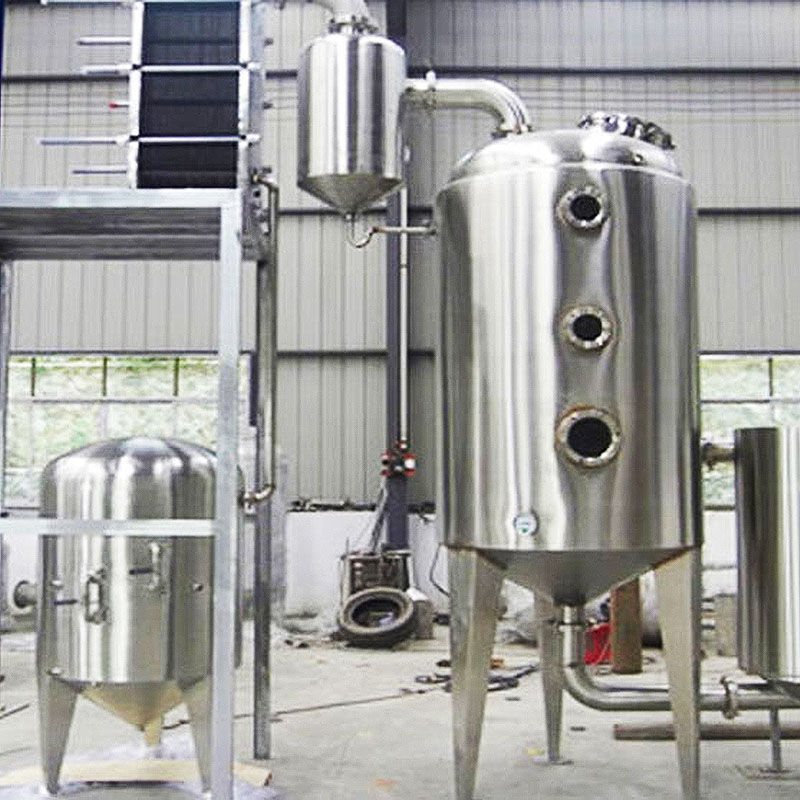Evaporative Crystallizer: A Comprehensive Analysis of Working Principle, Technical Features, and Industrial Applications
Release time:2025-09-20
Visits:101
The evaporative crystallizer is a core device in industrial production for achieving solution concentration and crystal separation. Through the synergistic effect of evaporation and crystallization processes, it significantly improves the purity of materials and the utilization rate of resources, and is widely used in key fields such as chemical engineering, pharmaceuticals, and environmental protection. This article will systematically analyze its technical advantages, working modes, and industry - suitable scenarios.
I. Core Technical Advantages
1. High - efficiency Evaporation and Energy - saving Features
The evaporative crystallizer uses multi - effect series or mechanical vapor recompression (MVR) technology. Through gradient heating and energy cycle design, it significantly reduces steam consumption. For example, a three - effect evaporation system can reduce energy consumption by more than 60%, which is particularly suitable for treating high - concentration wastewater or large - scale production scenarios.
2. Vacuum Low - temperature Evaporation to Protect Material Activity
The equipment operates in a negative - pressure environment, reducing the boiling point of the solution by 20 - 40°C, thus avoiding the damage of high temperature to thermosensitive components (such as biological agents and food additives). This mode also suppresses oxidation reactions to ensure product stability.
3. Forced - circulation Anti - scaling Technology
Equipped with a large - flow circulation pump, the material liquid is pushed to flow through the heating tube at a velocity of 3 - 5 m/s, effectively scouring the tube wall and inhibiting crystal accumulation. Compared with the natural - circulation system, the heat - transfer efficiency is increased by more than 25%, which is especially suitable for treating high - viscosity or easily crystallized solutions.
4. Intelligent Control System for Precise Process Regulation
Integrated with PLC and DCS automation modules, it can monitor the solution concentration, temperature, and pressure parameters in real - time and dynamically adjust the evaporation rate and crystal particle size. This technology can control the crystal particle size deviation within ±5%, meeting the requirements of high - end fields such as pharmaceuticals and electronic - grade chemicals.
II. Modular Structure and Selection Strategy
1. Composition of Core Components
- Shell - and - tube Heater: Made of titanium or duplex stainless steel, it can withstand chloride - ion corrosion, with a service life of more than 10 years.
- Cyclone Separator: It can achieve efficient separation of gas, liquid, and solid phases, with the solid content in the mother liquor less than 0.1%.
- Condensate Recovery System: More than 95% of the secondary steam is converted into distilled water for reuse, achieving zero wastewater discharge.
2. Equipment Type Adaptation Schemes
- Single - effect Type: Suitable for batch production with a treatment capacity < 5 m³/h, such as in laboratories or small - and medium - sized pharmaceutical enterprises.
- Multi - effect Type (3 - 5 effects): Used for treating more than 100 tons of chemical wastewater per day or large - scale salt crystallization. The energy - consumption cost is 70% lower than that of the single - effect type.
- MVR Type: With a fully automatic electric drive system, the comprehensive energy - efficiency ratio reaches 1:20, which is especially suitable for areas with high energy prices.
III. Typical Industry Solutions
1. Treatment of High - salt Wastewater
For wastewater with a salt content > 15% in the electroplating and petrochemical industries, the evaporative crystallizer can achieve a 95% reduction in volume and simultaneously recover industrial salts such as sodium chloride and sodium sulfate. A case of a coking plant shows that treating 100,000 tons of wastewater per year can generate 8 million yuan in by - product revenue.
2. Crystallization Process in the Pharmaceutical Industry
Through gradient evaporation with a temperature - control accuracy of ±0.5°C, antibiotic raw materials meeting the USP standard can be prepared. For example, the crystallization purity of cephalosporin drugs can reach 99.9%, and the batch stability is increased by 30%.
3. Refinement of Food - grade Products
In the production of sodium gluconate, citric acid, etc., the inner wall of the equipment is treated with 316L electrolytic polishing, meeting the GMP cleanliness standard, and the product's microbial indicators meet the export certification requirements.
4. Resource Utilization of Smelting Waste Liquid
When treating pickling waste liquid from hydrometallurgy, through pH regulation and segmented crystallization technology, metal salts such as copper and nickel can be recovered simultaneously, with a resource recovery rate > 85%, and the treatment cost is 40% lower than that of the traditional incineration method.
IV. Equipment Selection and Operation and Maintenance Points
1. Analysis of Material Characteristics
It is necessary to detect the boiling - point curve, crystal growth rate, and scaling tendency of the solution in advance. For mixed liquids containing organic matter, it is recommended to add a pretreatment section to prevent foaming.
2. Crystal Form Control Technology
Using ultrasonic assistance or adding crystal seeds for directional crystallization induction can obtain uniform crystals of 200 - 800 μm, reducing the subsequent drying energy consumption. After a potassium sulfate project adopted the crystal - seed technology, the centrifuge efficiency increased by 50%.
3. Anti - blockage Design
By setting automatic flushing nozzles in the conical section of the separator and combining with a 2 - hour online cleaning (CIP) program per week, the number of unplanned shutdowns can be reduced by more than 90%.
Through technological innovation and process optimization, modern
evaporative crystallizers have developed into intelligent equipment with both environmental and economic benefits, promoting the green transformation of industrial production and the construction of a resource - recycling system.

